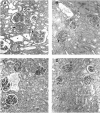Acceleration of autoimmunity by organochlorine pesticides in (NZB x NZW)F1 mice
- PMID: 15743722
- PMCID: PMC1253759
- DOI: 10.1289/ehp.7347
Acceleration of autoimmunity by organochlorine pesticides in (NZB x NZW)F1 mice
Abstract
Systemic lupus erythematosus (SLE) is an autoimmune disorder that affects women more frequently than men. In the (NZB times NZW)F1 mouse, a murine SLE model, the presence or absence of estrogen markedly influences the rate of progression of disease. Three organochlorine pesticides with estrogenic effects were administered chronically to ovariectomized female (NZB times NZW)F1 mice, and we measured the time to development of renal disease, the principal clinical manifestation of lupus in this model. Treatment with chlordecone, methoxychlor, or o,p -dichlorodiphenyltrichloroethane (o,p -DDT) significantly decreased the time to onset of renal impairment, as did treatment with 17ss-estradiol used as a positive control. In an expanded study of chlordecone, we found a dose-related early appearance of elevated anti-double-strand DNA autoantibody titers that corresponded with subsequent development of glomerulonephritis. Immunohistofluorescence confirmed early deposition of immune complexes in kidneys of mice treated with chlordecone. These observations are consistent with an effect of these organochlorine pesticides to accelerate the natural course of SLE in the (NZB times NZW)F1 mouse. Although we originally hypothesized that the effect on progression of autoimmunity was due to estrogenic properties of the pesticides, autoimmune effects and estrogenicity, assessed through measurement of uterine hypertrophy, were not well correlated. This may indicate that uterine hypertrophy is a poor indicator of comparative estrogenic effects of organochlorine pesticides on the immune system, or that the pesticides are influencing autoimmunity through a mode of action unrelated to their estrogenicity.
Figures






Similar articles
-
Acceleration of autoimmunity by organochlorine pesticides: a comparison of splenic B-cell effects of chlordecone and estradiol in (NZBxNZW)F1 mice.Toxicol Sci. 2007 Sep;99(1):141-52. doi: 10.1093/toxsci/kfm137. Epub 2007 Jun 19. Toxicol Sci. 2007. PMID: 17578864
-
Comparison of chlordecone effects on autoimmunity in (NZBxNZW) F(1) and BALB/c mice.Toxicology. 2006 Feb 1;218(2-3):81-9. doi: 10.1016/j.tox.2005.03.018. Epub 2005 Nov 22. Toxicology. 2006. PMID: 16309813
-
Diminished prolactin from chlordecone treatment in ovariectomized (NZBxNZW)F(1) mice.Int Immunopharmacol. 2007 Dec 15;7(13):1808-12. doi: 10.1016/j.intimp.2007.08.020. Epub 2007 Sep 17. Int Immunopharmacol. 2007. PMID: 17996692 Free PMC article.
-
Estrogenic action of DDT analogs.Am J Ind Med. 1983;4(1-2):163-73. Am J Ind Med. 1983. PMID: 6188376 Review. No abstract available.
-
[Chlorinated hydrocarbon insecticides(DDT, methoxychlor, HCH etc.)].Nihon Rinsho. 2000 Dec;58(12):2417-21. Nihon Rinsho. 2000. PMID: 11187730 Review. Japanese.
Cited by
-
A female preponderance for chemically induced lupus in SJL/J mice.Clin Immunol. 2007 Jan;122(1):101-7. doi: 10.1016/j.clim.2006.09.009. Epub 2006 Nov 1. Clin Immunol. 2007. PMID: 17084107 Free PMC article.
-
DNA methylation 101: what is important to know about DNA methylation and its role in SLE risk and disease heterogeneity.Lupus Sci Med. 2018 Jul 25;5(1):e000285. doi: 10.1136/lupus-2018-000285. eCollection 2018. Lupus Sci Med. 2018. PMID: 30094041 Free PMC article.
-
Impact of early life ovariectomy on blood pressure and body composition in a female mouse model of systemic lupus erythematosus.Am J Physiol Regul Integr Comp Physiol. 2014 Oct 15;307(8):R990-7. doi: 10.1152/ajpregu.00038.2014. Epub 2014 Aug 20. Am J Physiol Regul Integr Comp Physiol. 2014. PMID: 25324553 Free PMC article.
-
Pesticide use and risk of end-stage renal disease among licensed pesticide applicators in the Agricultural Health Study.Occup Environ Med. 2016 Jan;73(1):3-12. doi: 10.1136/oemed-2014-102615. Epub 2015 Jul 15. Occup Environ Med. 2016. PMID: 26177651 Free PMC article.
-
Toxicology of autoimmune diseases.Chem Res Toxicol. 2010 Mar 15;23(3):455-66. doi: 10.1021/tx9003787. Chem Res Toxicol. 2010. PMID: 20078109 Free PMC article. Review.
References
-
- Andersen HR, Vinggaard AM, Rasmussen TH, Gjermandsen IM, Bonefeld-Jorgensen EC. Effects of currently used pesticides in assays for estrogenicity, androgenicity, and aromatase activity in vitro. Toxicol Appl Pharmacol. 2002;179:1–12. - PubMed
-
- Ansell SM, Bedhesi S, Ruff B, Mahomed AG, Richards G, Mer M, et al. Study of critically ill patients with systemic lupus erythematosus. Crit Care Med. 1996;24:981–984. - PubMed
-
- ATSDR 1995. Toxicological Profile for Mirex and Chlordecone. Atlanta, GA:Agency for Toxic Substances and Disease Registry. - PubMed
-
- Churg J, Bernstein J, Glassock RJ. 1995. Lupus nephritis. In: Renal Diseases. Classification and Atlas of Glomerular Diseases (Churg J, Bernstein J, Glassock RJ, eds). New York:Igaku-Shoin, 151–169.
-
- Cummings AM. Methoxychlor as a model for environmental estrogens. Crit Rev Toxicol. 1997;27:367–379. - PubMed
Publication types
MeSH terms
Substances
Grants and funding
LinkOut - more resources
Full Text Sources
Medical
Miscellaneous

